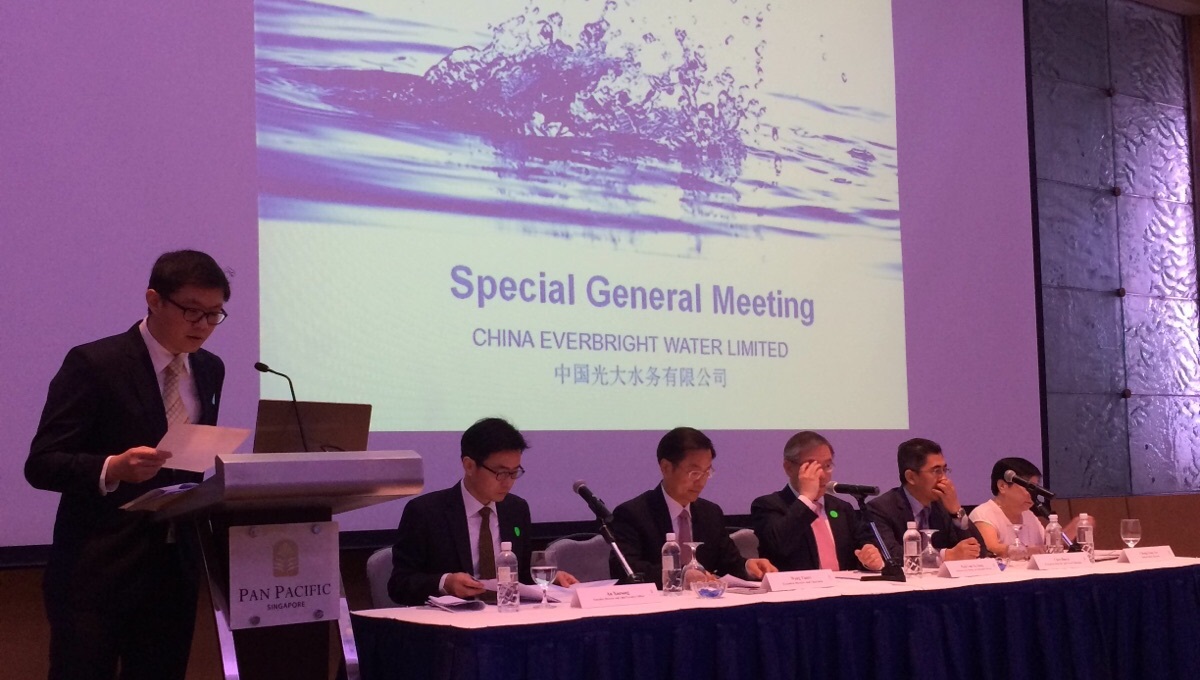 China Everbright Water shareholders passed a resolution at a special general meeting on 15 December to offset its RTO impairment loss against its share premium.
China Everbright Water shareholders passed a resolution at a special general meeting on 15 December to offset its RTO impairment loss against its share premium.
Photo by James Bywater
CHINA EVERBRIGHT WATER is on track to meet its 10 million-ton target of daily water treatment capacity by 2020. In the last one year following its RTO, it has already increased capacity by 32% to reach about 4.6 million tons a day.
Its RMB 800 million acquisition of Dalian Dongda (completed on 4 November) had taken the PRC water treatment industry by storm. The acquisition increased the Group’s total wastewater treatment capacity by 1.125 million tons a day. Just a month following its acquisition of Dalian Dongda, China Everbright Water won the tender for a resuable water project in Pukou, Nanjing, Jiangsu.
The Pukou reusable water project has a designed reusable water supply capacity of 40,000 tons per day. Construction will take place in two phases. Phase I will be constructed at a total investment cost of RMB 45.7 million. Phase I is expected to commence operation in 2016 with capacity for 20,000 tons of recycled water daily.
 Chairman Wang Tian Yi had announced at the previous AGM his intentions to increase the Group's water treatment capacity to 10 million tons a day in 3 to 5 years. NextInsight file photoAt its special general meeting on 15 December, shareholders passed a mandate to reduce the Group’s share premium and ratified a share buy-back.
Chairman Wang Tian Yi had announced at the previous AGM his intentions to increase the Group's water treatment capacity to 10 million tons a day in 3 to 5 years. NextInsight file photoAt its special general meeting on 15 December, shareholders passed a mandate to reduce the Group’s share premium and ratified a share buy-back.
Non-executive independent director, Paul Lim, explained the rationale for the share premium reduction exercise in response to an impairment loss of HK$4.699 billion in FY2014.
The impairment loss related to the value of shares issued to China Everbright Holdings for the Group’s takeover of China Everbright Water International Ltd (CEWIL) that was deemed by independent auditors to be irrecoverable. The cost of investment in CEWIL was booked at HK$11.6 billion, some HK$4.7 billion higher than its recoverable value. CEWIL’S recoverable value (fair value less RTO expenses) was HK$6.9 billion.
Shareholders passed a mandate to offset the impairment loss against the Group’s share premium of (HK$12.1 billion as at September 2015) and designate the balance monies under a “contributed surplus” account. This share premium included the Group’s RTO share premium of about HK$9.7 billion, which was book value of CEWIL in excess of the par value of the purchase consideration shares.
The following is a summary of questions raised by shareholders at the meeting and the replies provided by the management. Q: What is share premium? The concept of share premium is essentially the difference between the share issue price and the par value of the share. In the past in Singapore, we did have this concept of “par value” of shares but that has been removed with the revision of the Companies Act. As a result, in Singapore companies today, we do not see a share premium disclosed separately. It is usually included as part of share capital. The capital reduction exercise reduces the Group’s share capital by offsetting it against accumulated loss. Under the Bermuda Companies act, if a company has accumulated losses, or if it has net losses for a relevant year, the company may not distribute dividends that year. As a Bermuda-incorporated entity, the Group can utilize the credit amount arising from a reduction of its share premium account to offset accumulated losses and thereby boost retained earnings. This will enhance the Group’s ability to distribute dividends.
Our dividend policy depends on our financial results for the period as well as our capital expenditure requirements. At the moment, we are looking to expand our waste water capabilities up to a capacity of 10 million tons in 3 to 5 years. The Chairman mentioned this in the previous AGM. We will strike a balance between sustaining our growth momentum and rewarding shareholders in the form dividends. We are in a growing and expansionary phase, unlike mature companies like SIA. Thus, we cannot say for now how much of retained earnings we are able to pay out as dividends but we understand the perspective of shareholders and shall continue to keep this in mind going forward. Q: Based on the current 4.6 million-ton capacity, what amount of recurring income can we expect? How does that change with the expansion toward your 10 million ton target? The consolidated capacity from the RTO and the recent acquisition of Dalian Dongda is 4.6 million tons of “contracted capacity”. The actual current capacity is 3.5 million tons. Based on current water tariff rates, we expect a rough amount of HK$2 billion in recurring income. We have been aggressive in trying to persuade the government to increase the water tariffs. This has been successful with recent hikes of 50% in some areas and 5% in others. There have been 10 projects whereby we have successfully negotiated tariff hikes. The government is very supportive of the waste water industry and we expect recurring income figures to increase going forward.
If we are to pay a dividend next year, we have to get the resolution passed now.
As with all share buybacks, the company looks at the best way to maximize ROE for shareholders. There is no definitive time for when the company will conduct share buy backs. Q: On the one hand, you are saying you need to conserve capital for growth, yet you are proposing this share buyback mandate. In addition, the major shareholder already has 74% of the company. Share buybacks may decrease the float and liquidity. Thus, the focus should be on dividends as the market will then look at your stock. You should conserve cash for growth and dividends. We see the share buyback mandate as a tool to protect shareholders value during bad market conditions such as that seen early this year in China. The resolution for share buyback is a tool for us to signal to the market that we are confident of the company's fundamentals during bad stock market conditions. We do not need to spend significant cash amounts for our share buyback program. The balance sheet of the company is strong. The share premium reduction does not have an impact on the group’s cash flow or balance sheet. This is just an accounting issue and does not have any material impact on the financial statements. |